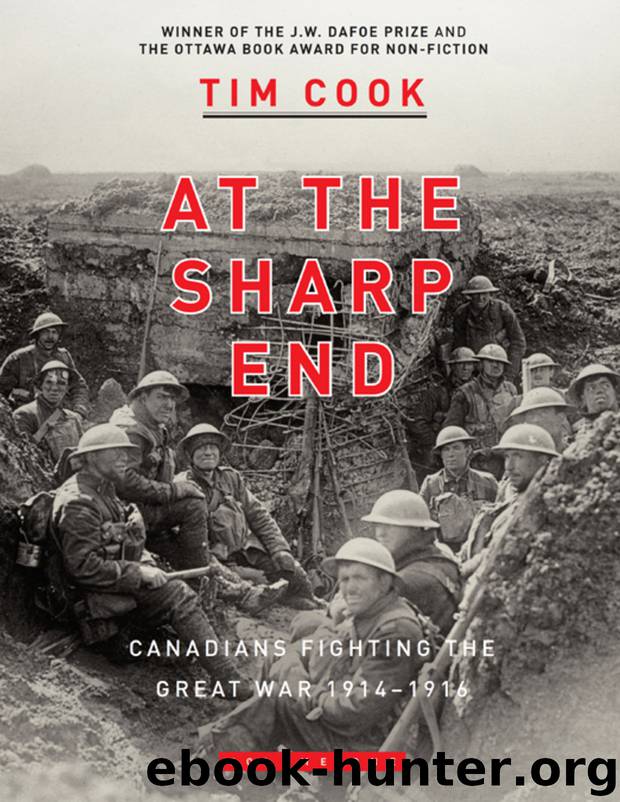At the Sharp End Volume One by Tim Cook

Author:Tim Cook
Language: eng
Format: epub
Publisher: Penguin Canada
Published: 2016-08-15T16:00:00+00:00
CHAPTER 23
CREATING THE CORPS
September 1915–March 1916
“The war keeps up its everlasting grind and everyone plods unrelentingly on,” wrote discouraged front-line officer Lieutenant F.G. Newton to friends at home.1 Soldiers at the front understood well that the Germans were far from cracking. With politicians and kings refusing to negotiate, the only way to end the war was to hack a hole in the German lines to get to the open country beyond, but that would mean a series of frontal assaults against barbed wire, trenches, and hardened defences protected by machine guns, artillery, and a seemingly never-ending flow of reinforcements.
The summer of 1915 had provided a respite for the Canadians to recover from the shock of the Second Battle of Ypres and the Battle of Festubert. During this period, soldiers spent more time fighting lice and loneliness than Germans, but still the ever-present spectre of snipers and shells took its daily toll on the men in the trenches. Lives continued to be lost in disconsolate dribs and drabs: a man dismembered by a shell in one part of the trench, another shot through the arm somewhere in the next bay, or a raid gone bad, leaving a handful of corpses in No Man’s Land. Companions were slowly claimed, one after another.
The troops were also suffering from a reinforcement problem, as most of the men in England were being trained for a second division, and so were not yet ready to be sent forward. In August, a strength report for the Canadian Division’s infantry battalions in Europe noted that their number of men ranged from a high of 1,025 in the 16th Battalion to a shocking low of 426 in the 1st Battalion, with most of the battalions fielding around 800 men.2 Not until the end of the year did infantry battalions return to full strength.
In September 1915, a new Canadian division arrived in France. The 2nd Division had been raised in Canada almost immediately after the First Contingent’s armada had sailed. The thousands of men who had been turned down in disappointment in August 1914 responded to the new call to arms. Units were raised from across the country, although the West provided a disproportionate number of enlistees. The new 4th Infantry Brigade comprised four battalions raised in Ontario: the 18th (London), 19th (Toronto), 20th (Toronto), and 21st (Kingston). The division’s middle brigade, the 5th, included a mixture of forces drawn from Quebec and the Maritimes: the 22nd Battalion, raised in Quebec, would be the only French-Canadian battalion in the entire corps, while the 24th was formed largely around the English-speaking Victoria Rifles of Canada, a militia regiment from Montreal. The 25th and 26th Battalions were raised from recruiting stations at Halifax, Nova Scotia, and Saint John, New Brunswick, but men from across the two provinces were among the enlistees. The 6th Brigade was raised in the West and consisted of the 27th (Winnipeg), 28th (Winnipeg), 29th (Vancouver), and 31st (Calgary) Battalions.
While the new division’s battalions were linked to major cities
Download
This site does not store any files on its server. We only index and link to content provided by other sites. Please contact the content providers to delete copyright contents if any and email us, we'll remove relevant links or contents immediately.
The Radium Girls by Kate Moore(10937)
The Templars by Dan Jones(4203)
100 Deadly Skills by Clint Emerson(4101)
Rise and Kill First by Ronen Bergman(4035)
The Doomsday Machine by Daniel Ellsberg(3745)
The Rape of Nanking by Iris Chang(3539)
Killing England by Bill O'Reilly(3471)
Hitler in Los Angeles by Steven J. Ross(3458)
Stalin by Stephen Kotkin(3101)
12 Strong by Doug Stanton(3066)
Hitler's Monsters by Eric Kurlander(2744)
Darkest Hour by Anthony McCarten(2658)
Blood and Sand by Alex Von Tunzelmann(2618)
The Art of War Visualized by Jessica Hagy(2429)
Hitler's Flying Saucers: A Guide to German Flying Discs of the Second World War by Stevens Henry(2308)
The Code Book by Simon Singh(2226)
The Second World Wars by Victor Davis Hanson(2140)
Babylon's Ark by Lawrence Anthony(2079)
Tobruk by Peter Fitzsimons(2070)
